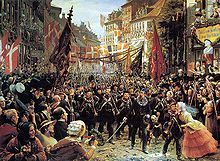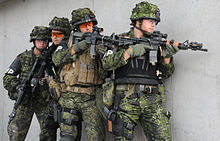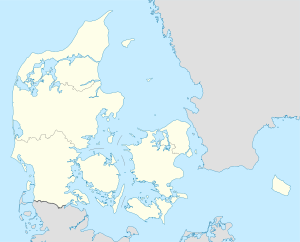- Royal Danish Army
-
Royal Danish Army
Hæren
Logo of "Hæren"Founded 1614-11-17[1] Country  Denmark
DenmarkSize Regular Army Active: 10,560 Regular Army Reserve: 4,070
Conscripts Active: 2,150
Conscripts Reserve: 12,000
Army personnel in the joint services: 2,300[2]
809 tracked and 257 wheeled armoured vehicles[3]
Part of Military of Denmark Engagements Thirty Years' War (1625-29)
Torstenson War (1643-45)
Second Nordic War (1657-60)
Scanian War (1675-79)
Great Nordic War (1700 & 1709-20)
First Schleswig War (1848-51)
Second Schleswig War (1864)
Operation Weserübung-Süd (1940)
Operation Bøllebank (1994)
War in Kosovo (1998-1999)
War in Afghanistan (2001–present)
Iraq War (2003-07)Commanders Chief of Defence General Knud Bartels Chief of Army Operational Command Major-General Agner Rokos Insignia Identification
symbol
The Royal Danish Army is the land warfare branch of the Danish Defence Forces, together with the Danish Home Guard.
For the last decade, the Royal Danish Army has undergone a massive transformation of structures, equipment and training methods, abandoning its traditional role of anti-invasion defence, and instead focusing on out of area operations by, among other initiatives, reducing the size of the conscripted and reserve components and increasing the active (standing army) component, changing from 60% support structure and 40% operational capability, to 60% combat operational capability and 40% support structure. When fully implemented, the Danish Army will be capable of deploying 1,500 troops permanently on three different continents continuously, or 5,000 troops for a shorter period of time, in international operations without any need for extraordinary measures such as parliamentary approval of a war funding bill.
Contents
Brief organizational history
The Royal Danish Army was originally designed to prevent conflicts and war, maintain Denmark's sovereignty and protect her interest. With time, these goals have developed into also encompassing the need to protect freedom and peaceful development in the world with respect for human rights.
 Danish military veterans are welcomed home and greeted as victors in the streets of Copenhagen, upon return from the First Schleswig War, 1849. The banner reads 'Thank you, you who fell, and you who stayed behind'
Danish military veterans are welcomed home and greeted as victors in the streets of Copenhagen, upon return from the First Schleswig War, 1849. The banner reads 'Thank you, you who fell, and you who stayed behind'
Originally, the Danish King commanded the Army into battle himself and fought on the battlefield. In 1815, however, as a result of continued evolution and division of command, four general commands were created with the King as the supreme authority: Zealand and adjacent islands, Funen Langeland, Jutland and the duchies of Schleswig and Holstein. At the same time, the need for maintenance of the army in peacetime became pertinent, and the Army Operational Command was established.
The Royal Danish Army has historically been an integral part of the defence of Denmark and thus involved in warfare, skirmishes and battles continuously to protect her interests. Most notably various territorial wars with Sweden, Russia and Prussia, the Napoleonic Wars on the side of France, and the Second World War, controversially and famously against the wishes of the Danish government, which had ordered immediate surrender to Germany. In modern times the Royal Danish Army has also become the backbone of Danish international missions, such as those in Kosovo, Iraq and Afghanistan.
Recent deployments
The Royal Danish Army has been committed to a number of UN and NATO peacekeeping and unconventional warfare operations since becoming involved in the Yugoslav Wars under UN mandate in 1994, most notably in the famous Operation Bøllebank. The Royal Danish Army was also engaged in the Kosovo War and continues to this day to maintain peacekeeping operations in Kosovo under UNMIK, together with the Danish Home Guard. Furthermore, the Royal Danish Army was involved in the War in Iraq from 2003-2007 with a significant contingent of soldiers responsible for creating and maintaining peace in the province of Basra, together with the British.
Denmark lost its first soldier in Iraq on 17 August 2003: Preben Pedersen a 34-year-old Lance Corporal with the Jutland Dragoon Regiment became the first coalition soldier not from the USA or UK to die in the Iraq War. Since 2001, the Royal Danish Army has also been involved in the War in Afghanistan. For the past few years, the Royal Danish Army and the British Army have been involved in heavy clashes with the Taliban in the Helmand Province, where about 760 Danish soldiers control a large battlegroup.
Units of the Royal Danish Army
The Danish military has recently restructured its internal organization heavily, and now relies on a more flexible and modern structure than before, geared towards upholding national sovereignty and participating in the international war on terror and international peacekeeping missions under NATO and UN mandate. In the Royal Danish Army, this has meant a restructuring where three of the most traditional and historic regiments in Europe provide the cornerstone of Danish cavalry and infantry, flanked by five different support regiments and an elite unit of special forces. In addition to these, Denmark also relies on a large number of Army Reserves both for domestic military training and foreign missions.
Danish Military Police conduct advanced law enforcement training involving high risk arrest scenarios at the Grafenwöhr Training Area in Germany, 2009.
Cavalry
- Jydske Dragonregiment - Jutish Dragoons(I/JDR Armor Battalion, Operating Leopard 2 DK MBT and APC's M113G3DK)
- Gardehusarregimentet - Guard Hussar (III/GHR Recon Battalion)
Infantry
- Den Kongelige Livgarde - Royal Guard(I/LG Armor Infantry Battalion, operating several variations of M113G3DK and MOWAG Piranha, Mercedes G270 CDI/28 and CV9035 MK III)
- Gardehusarregimentet (I/GHR Armor Infantry Battalion) Operating (CV9035 MK III, Piranha, and APC's M113G3DK )
- Jydske Dragonregiment (II/JDR Armor Infantry Battalion) Operating (CV9035 MK III and APC's M113G3DK (Leopard 2A5DK))
Special Forces
- Jægerkorpset - Hunter Force or Huntsmen Corps (Danish Army Special Forces)
Support Arms
- Danske Artilleriregiment - Artillery
- Ingeniørregimentet - Engineers
- Telegrafregimentet - Signals
- Trænregimentet - Logistics
- Militærpolitiet - Military Police
Structure of the Royal Danish Army
The structure of the Danish army changed in 2001, when the remaining infantry regiments were amalgamated, leaving four remaining, but larger and more effective, combat regiments, two cavalry and two infantry regiments. Besides these units, a school structure is in operation, with two army officer schools, one for the airforce and one for the navy, as well as a sergeant school and various other educational institutions aimed at training and educating future personnel.
Cavalry
The armoured corps of the Danish army consists of an armoured battalion, an armoured reconnaissance battalion and an armoured training battalion; they were once part of two separate cavalry regiments:
- Armoured Battalion
- I Panserbataljon, Jydske Dragonregiment(Armoured Battalion)
- Reconnaissance Battalion
- III Opklaringsbataljon, Gardehusarregimentet (Reconnaissance Battalion)
Infantry
The infantry corps of the Danish army consists of seven battalions, which six of them carry the tradition of two regiments:
- Mechanised Infantry:
- I Panserinfanteribataljon, Den Kongelige Livgarde (Armoured Infantry Battalion)
- II Panserinfanteribataljon, Den Kongelige Livgarde(Armoured Infantry Battalion(Formed August 2011))
- I Panserinfanteribataljon, Gardehusarregimentet (Armoured Infantry Battalion)
- II Panserinfanteribataljon, Gardehusarregimentet (Armoured Infantry Battalion(Formed August 2011))
- II Panserinfanteribataljon, Jydske Dragonregiment(Armoured Infantry Battalion(Formed February 2011))
- Training Battalion
- III Uddannelsesbataljon Den Kongelige Livgarde (Basic Training Battalion)
- IV Panserinfanteribataljon, Gardehusarregimentet (INTOPS Training Battalion)
- IV Panserinfanteribataljon, Jydske Dragonregiment (INTOPS Training Battalion)
- V Uddannelsesbataljon, Gardehusarregimentet (Basic Training Battalion)
- V Uddannelsesbataljonen, Jydske Dragonregiment(Basic Training Battalion)
Equipment
This is a list of equipment of the Royal Danish Army.
Armour
Main battle tanks, armoured vehicle-launched bridge, armoured recovery vehicle and related equipment
Main battle tanks
- Leopard 2A5DK (identical to a Leopard 2A6, but with various upgrades on the sight, target, communication and climate control systems, and without the L55 gun): (57[4])
Armoured recovery vehicles: (11[4])
- Bergepanzer 2 (ARV Leopard 1 Chassis)
Armoured vehicle-launched bridge: (10[4])
- Leopard 1 biber (AVLB Leopard 1 Chassis)
Mine clearing vehicles: (16[4])
- Hydrema 910 MCV
Infantry fighting vehicle and armoured carriers
Combat Vehicle 90:- CV9035 MkIII infantry fighting vehicle: (Lemur 12.7mm OHW) (45[4])
M113, all heavily updated to M113 G3 DK and M113 G3 Waran in various versions: (416[4])
- Armored personnel carrier
- Command vehicles
- Repair vehicle
- Fitters Vehicle
- TOW carrier
- Ambulance
- Combat engineers vehicle
- Tactical air control party carrier
- Fire fighting vehicle
Mowag Piranha III 8x8 in H and C variants: (90[4])
- Armoured personnel carrier (Lemur 12.7mm OHW)
- Armoured ambulance
- Communications and informations systems carrier
- Tactical air control party carrier
- Command and control vehicle
- Reconnaissance vehicle
Patria XA-185: (11)
- Armoured ambulance
Mowag Eagle 4x4 I and IV:
- Eagle I reconnaissance vehicle (ca. 30 in storage)
- Eagle IV Patrol vehicle (Lemur 12.7 mm OHW) (91[4])
Mowag Duro IIIP 6x6: (29)
- Armoured ambulance
HMMWV: (22[4])
- Fast attack vehicle
- TOW carrier
- Utility vehicle
Supacat HMT 400:
- Patrol vehicle (SOF)
Aircraft
Helicopters All army helicopters have been transferred to Helicopter Wing Karup, a joint helicopter command under the Royal Danish Air Force:
- Fennec AS550: (8) (plus 4 in storage)
- EH-101 Merlin Joint Supporter: (14)
Unmanned Aerial Vehicles:
- Raven B short range tactical UAV
Artillery
Field artillery, mortars, and related equipment
M109 howitzerA3DK 155 mm self-propelled howitzer: (12[4])
- 120 mm heavy mortar
Explosivos Alaveses 60 mm mortars: (90[4])
- 60 mm light infantry mortar
- 60 mm commando mortar
Danish Army Low Level Air Defence System (DALLADS):
- Air Defence Control Centers (Based on Termas T-Core C4I system)
- Medium Range Sensors (Thales Group RAC 3D radar, range 100 km)
- Short Range Sensors (Thales Group 2D radar, range 20 km)
- Logistics units
Other vehicles
Trucks, lorrys, and other vehicles
MAN trucks of various models and versions, for instance:
- MAN HX 77 Logistic vehicle (170[4])
- MAN SX 45 Armoured logistic vehicle (30[4])
- MAN 8.136 Light utility truck
- MAN 13.192 Medium utility truck
- MAN 27.314 Heavy utility truck
- MAN 26.372 Fuel truck
- MAN 25.322 Container handling truck
- MAN 27.314 Mobile communication center
- MAN 40.400 Prime MBT mover
- MAN 35.460 Heavy equipment transporter
- MAN 41.372 Heavy wrecker
- MAN 41.480 Recovery vehicle
Mercedes Geländewagen: (app. 2200[4])
- G240 Utility
- G270 Armoured utility
- G270 Reconnaissance vehicle et al.
- G290 Ambulance et al.
- G300 EOD
Motorcycles:
- BMW F650GS
- BMW R850RT
- KTM 450 EXC
Service rifles and carbines
All rifles, carbines, submachine guns and machine gunes issued to consripts as well as regular personnel are equipped with either a C79 optical sight or an Aimpoint CompM4 to allow the soldier to attach his night vision goggles to optic sight.
- GV M/10 5.56 mm (Colt Canada C8IUR rifle)
- GV M/95 5.56 mm (Colt Canada C7 rifle)
- K M/96 5.56 mm 5.56 mm (Colt Canada C8 carbine)
Machine-guns and light machine-guns
- LSV M/04 5.56 mm (Colt Automatic Rifle)
- Mg M/07 5.56 mm (FN Herstal Minimi) (in limited use and under evaluation for further procurement to replace the LSV M/04)
- Mg M/50 12.7 mm (M2 Browning machine gun)
- LMG M/62 7.62 mm (Rheinmetall MG 3)
Sniper rifles
- M/04 SAKO TRG42RH Cal. 338LM (Sako TRG)
- HK 417
- MRG M/95 12.7 mm (Barrett M95) (primary used for EOD)
Sidearms and Submachine-guns
- P M/49 9 mm (Sig P210)
- USP9 SD 9 mm
- Glock 17 9 mm
- Glock 19 9 mm
- MP5 9 mm (Heckler & Koch MP5)
Infantry antitank weapons
- DYKN M/85 84 mm (Carl Gustav recoilless rifleM3) (774[4])
- PVV M/97 84 mm (AT-4CS)
Infantry mortars and grenade launchers
- LMT M/06 60 mm Kombi mortar (Explosivos Alaveses)
- LMT M/06 60 mm Commando mortar (Explosivos Alaveses)
- GRK M/03 40 mm (Colt Canada M203A1)
- AGK 40 mm (automatic grenade launcher)
Grenades and mines
- Håndgranat M/54 (540 grams fragmentation hand grenade)
- Røghåndgranat M/57 (phosphor based grenade)
- Røghåndbombe M/77 (phosphor based grenade)
- Røghåndbombe M/93 (phosphor based grenade)
- M/05 Flashbang device
- M/05 Sting hand grenade
- M/05 CS gas hand grenade
- Alarmmine M/87 (Alarm mine, pyrotechnics)
- Alarmblus M/62 (Alarm mine, pyrotechnics)
Bayonet, field knife, and entrenching tool
- Bajonet M/95, bayonet (bayonet M7)
- Feltkniv M/96, field knife (Glock Feldmesser)
- Feltspade M/96, field shovel (Glock Feldspaten)
Uniforms, personal load-carrying equipment, and personal protection equipment
- Uniformssystem M/84, Standard uniform system in cotton and polyester, mainly used in the winter
- Uniformssystem M/01, Lightweight material in ripstop, exists in both desert camouflage and M/84 camouflage
- Oppakningssystem M/96, load carrying system (PLCE in Danish M/84 camouflage)
- Fragmentationsvest M/2000, body armour
- Hjelm M/96, helmet (SPECTRA helmet)
- Hjelm M/10, helmet (Tactical Ballistic Helmet version 2 (TBHII)
- ABC-maske M/96, field NBC protective mask
- ABC-dragt M/96, field NBC protective suit
Tactical and communication equipment
- PRR M/07, Personnel Role Radio (Bowman)
- DA/PRC-361, Squad Radio (Racal Acoustics)
- DA/PRC-371, Platoon Radio (Racal Acoustics)
- (AN/PVS-14) Nat-brille M/03, Monocular Night Vision Device
- (AN/PVS-7) Nat-brille M/97, Binocular Night Vision Device
Insignia
NATO Code OF-10 OF-9 OF-8 OF-7 OF-6 OF-5 OF-4 OF-3 OF-2 OF-1 OF(D) Student Officer  Denmark (Edit)
Denmark (Edit)No Equivalent 











General Generalløjtnant Generalmajor Brigadegeneral Oberst Oberstløjnant Major Kaptajn Premierløjtnant Løjtnant Sekondløjtnant NATO Code OR-9 OR-8 OR-7 OR-6 OR-5 OR-4 OR-3 OR-2 OR-1  Denmark (Edit)
Denmark (Edit)


No equivalent 





No insignia Chefsergent Seniorsergent Oversergent Sergent OFASP-sergent Korporal Overkonstabel af 1. grad Overkonstabel Konstabel Menig
(conscript private)Internal restructuring
Because of the massive internal restructuring over the last decade to create an extremely modern and professional army, the Royal Danish Army no longer operates any aircraft under its own command after the last 12 helicopters of the Eurocopter Fennec AS 550 were transferred to the Royal Danish Air Force in 2004. Furthermore, a number of regiments and units have been disbanded, and instead amalgamated into other, larger divisions and units, centered in operation-specific hubs across the country.
Disbanded army regiments and units
-
This list is incomplete; you can help by expanding it.
- Danske Livregiment, (1.Regiment).
- Slesvigske Fodregiment, (2.Regiment).
- Prinsens Livregiment, (3.Regiment).
- Sjællandske Livregiment, (4.Regiment).
- Falsterske Fodregiment, (5.Regiment).
- Fynske Livregiment, (6.Regiment).
- Kongens Jydske Fodregiment, (7.Regiment).
- Dronningens Livregiment, (8.Regiment).
- Fodfolkets Pionererkommando, (9.Regiment).(Merge into 2.Regiment in 1951)
- Feltherrens Fodregiment, (10.Regiment).(Merge into 8.regiment in 1951)
- Marineregimentet, (Bornholms Værn).
- Kronens Artilleriregiment, (1.Artilleri Regiment).
- Sjællandske Artilleriregiment, (2.Artilleri Regiment).
- Nørrejyske Artilleriregiment, (3.Artilleri Regiment).
- Sønderjyske Artilleriregiment, (4.Artilleri Regiment).
- Kongens Artilleriregiment. (1982–2005)
- Dronningens Artilleriregiment. (2000–2005)
- Sjællandske Ingeniørregiment.
- Jydske Ingeniørregiment.
- Sjællandske telegrafregiment.
- Jydske telegrafregiment.
- Sjællandske Trainregiment.
- Jydske Trainregiment.
- Sjællandske Luftværnsregiment.
- Jydske luftværnsregiment.
See also
- Dancon/Irak
- International Security Assistance Force
- Equipment of the Royal Danish Army
- Royal Danish Navy
- Royal Danish Air Force
References
- ^ Nørby, Søren (2006). Det danske forsvar. København: Det historiske hus. p. 39. ISBN 87-11-11853-9.
- ^ The Danish Defence Agreement 2005 - 2009 - Army, retrieved June 25th 2008
- ^ Equipment used in the Army, retrieved June 25th 2008
- ^ a b c d e f g h i j k l m n o Arms and equipment of the army
- ^ http://forsvaret.dk/HOK/Nyt%20og%20Presse/ISAF/Pages/20MRAPk%C3%B8ret%C3%B8jeroverdragestilstyrkeniAfghanistan.aspx
Links to related articles Military of Denmark Services Command organisations Danish Defence Command · Army Operational Command · Admiral Danish Fleet · Tactical Air Command · Island Command Greenland · Island Command Faroes · Home Guard CommandService organisations Defence Acquisition and Logistics Organization · Defence Personel Administration Service · Danish Armed Forces Health Services · Defence Intelligence Service · Judge Advocate Corps · Defence Information & Welfare Service · Defence Estates & Infrastucture Organisation · Defence Internal Auditor · Defence Media AgencyHigher education facilities Royal Danish Defence College · Royal Danish Army Officers Academy · Royal Danish Naval Academy · Royal Danish Air Force Officers SchoolArmy units Danish Division · 1.Brigade · 2.Brigade · Danish Operative Logistical Group · Local defence region - Bornholm Defence · Jægerkorpset
Den Kongelige Livgarde · Jydske Dragonregiment · Gardehusarregimentet · Danske Artilleriregiment · Ingeniørregimentet · Telegrafregimentet · Trænregimentet · Danish International Logistical CenterNavy units 1st Squadron · 2nd Squadron · Naval Air Squadron · Danish Frogman Corps · Sirius Arctic Patrol · Danish Task GroupAir Force units Air Squadron 721 · Air Squadron 722 · Air Squadron 724 · Air Squadron 727 · Air Squadron 730 ·
Combat Support WingSpecial Force units Former regiments of the Royal Danish Army since 1945Danske Livregiment · Dronningens Artilleriregiment · Dronningens Livregiment · Falsterske Fodregiment · Feltherrens Fodregiment · Fynske Livregiment · Jyske Ingeniørregiment · Jyske Luftværnsregiment · Jyske Telegrafregiment · Kongens Artilleriregiment · Kongens Jyske Fodregiment · Kronens Artilleriregiment · Nørrejyske Artilleriregiment · Prinsens Livregiment · Sjællandske Artilleriregiment · Sjællandske Ingeniørregiment · Sjællandske Livregiment · Sjællandske Luftværnsregiment · Sjællandske Telegrafregiment · Slesvigske Fodregiment · Sønderjyske Artilleriregimentbefore 194511. Regiment · 12. Regiment · 13. Regiment · 14. Regiment · 15. Regiment · 1. Dragonregiment · 2. Dragonregiment · 3. Dragonregiment (1807) · 4. Dragonregiment · Fæstningsartilleriregimentet · KystartilleriregimentetArmies (land forces) in Europe Sovereign
states- Albania
- Andorra
- Armenia
- Austria
- Azerbaijan
- Belarus
- Belgium
- Bosnia and Herzegovina
- Bulgaria
- Croatia
- Cyprus
- Czech Republic
- Denmark
- Estonia
- Finland
- France
- Georgia
- Germany
- Greece
- Hungary
- Iceland
- Ireland
- Italy
- Kazakhstan
- Latvia
- Liechtenstein
- Lithuania
- Luxembourg
- Macedonia
- Malta
- Moldova
- Monaco
- Montenegro
- Netherlands
- Norway
- Poland
- Portugal
- Romania
- Russia
- San Marino
- Serbia
- Slovakia
- Slovenia
- Spain
- Sweden
- Switzerland
- Turkey
- Ukraine
- United Kingdom
- Vatican City
States with limited
recognition- Abkhazia
- Kosovo
- Nagorno-Karabakh Republic
- Northern Cyprus
- South Ossetia
- Transnistria
||sv:Danmarks armé]]
Categories:- Royal Danish Army
- Military insignia
Wikimedia Foundation. 2010.




